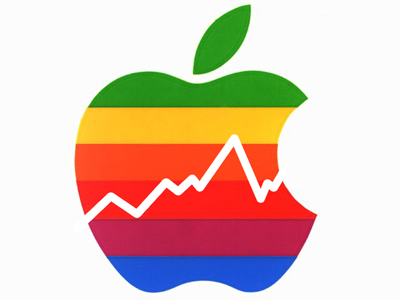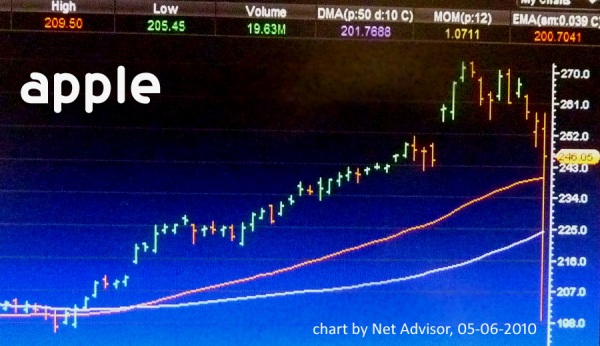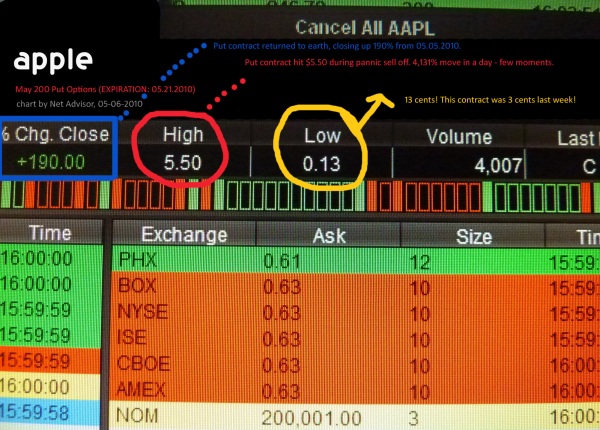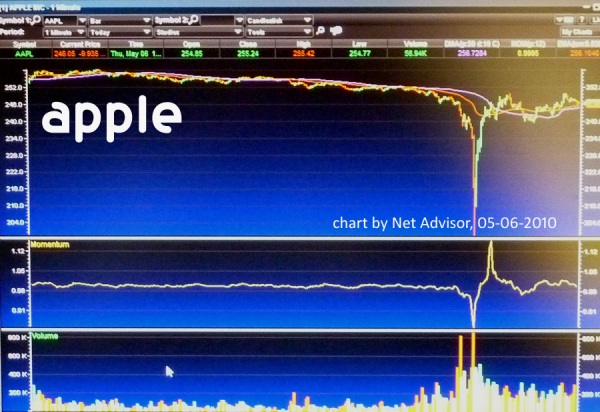05.09.2010 Original publish date
02.13.2016 update: Archived report under Financial Markets History
An Apple This Day Kept Some Traders at Bay
original article written by Net Advisor™
Flash Crash: A Bite Out of the Apple. We heard the news of the stock market rapidly falling with the Dow down 998 points at one point on Thursday May 6, 2010. One of the many securities I was closely following at the time was Apple, Inc. (NASDAQ: AAPL).
On April 1st I began citing concerns as to valuation of Apple stock. At the time the stock was the 3rd biggest company in the world, after Exxon Mobil and Microsoft and had just surpassed the size of Wal-Mart. Apple is a great innovative company with great products. And even the best of companies can become near term overvalued where the stock price rises to levels that may not be able to be sustained.
The reason for a stock to fall could be anything. News specific: Something that the company is doing that questions if the stock should be at current level; competition doing things that could impact sales; litigation risk such as where current or an ongoing lawsuit could mean the company might have to give up cash and or sales to a competitor; or it could be a crowded trade (story link gone) and even general market events could trigger a sell off.
Apple as a company has seemed that it could do no wrong, and in stock market terms, we call this a company that is “firing on all cylinders.” Usually at some point after I hear this, I get concerned. When everyone becomes bullish, analysts raise price targets, and they do so AFTER the stock hits all time high, it often suggests that a stock is overvalued near term. At someone point the stock is due for a modest correction, and it is usually painful for all the people who ran in and bought the last 10-20%+ upward movement in the stock.
On April 21, 2010, Apple reported impressing quarterly earrings and 13 analysts raised their price target for Apple (Source: Reuters). Apple stock hit an all-time (intraday) high at $272.46 on April 26, 2010 and has fallen ever since.
Enter the put option trade.
There are a number of ways one can profit from a falling stock.
One can go short, and make money as the stock falls, but they lose money if the stock rises. Another strategy could be to buy put options or use a combination of option strategies to either protect downside if one is long the stock, or to just profit on its anticipated prop in price.
I have had many good calls especially over the 2007-2008 financial crisis. However no one is always going to have good calls and timing can be off, and this Apple trade seemed to be one of those cases. I had taken a position to buy put contracts for May with a $200 strike. What this means is that for a small amount of money (around $1.08) per option contract (each contract equals 100 shares) , I was thinking that Apple’s stock could fall below $200 before Friday May 21, 2010. At that time the option will expire, so one would need to sell it or exercise it on or before that date. I am not going into the size of the position held, but for those doing the same trade at that time, it would cost $108.00 for each contract ($1.08 then current asking price x 100 shares per contract = $108.00).
As this sometimes occurs, my timing was off, or so it seemed, and Apple’s stock continued surging higher and higher. As the stock increases in value, the put option (thinking the stock will go lower), decreases in value. In fact, the value of that option got down to about 3 cents, virtually worthless. At that point, seeing red in the portfolio, and watching what looks like a total loss, I felt there was no point to sell the option and take the 3 cents (option price x number of contracts = buy or sell value) and go home, so I stuck with the trade.
For awhile I had thought about dollar cost averaging into the trade, and it would have cost virtually noting to do this, unless you do this with a large number of contracts. Usually good advice, but when it comes to options, if you are wrong, you could lose even more money. Taking the conservative route, and frustrated at the unrealized (paper) loss, I just sat on the trade. With Apple trading around $270, and 3 weeks to go before the option expires, it would take a miracle, or a disaster to see any recovery, let alone profit from this option.
Enter Greece, May 6, 2010.
On Thursday, May 6, 2010 TV pictures of live rioting against the Greek government was the final straw the market needed to send stocks across the board to a sell off. We had already been seeing stocks slide in price before this date, as if a normal stock correction was occurring. In fact, this Apple option went from 3 cents to 13 cents during this time, a 333% gain. However still underwater with a cost basis of about $1.08, I stayed with the trade. I didn’t think the stock could fall that far in so short of a time to recover, but still, stayed with the trade.
Then all of a sudden, that miracle occurred: Apple’s stock crashed. OK, so it is a miracle for those who are short the stock or has put options looking for a price decline. If one was long Apple, ouch!
Now, in my career in this business, the generally accepted but unofficial definition for a “crash” is a 20% down move in a single day:
Apple traded from a day high of $255 to roughly down to about $199; that would be about a $56 drop or a 21.96% move – a technical (intraday) crash. (Please see blue chart below. Click on charts below to enlarge images.)
Due to the massive volatility (downside movement) now created in Apple’s stock, that May $200 put option traded on May 6, 2010 from .13 cents to $5.50 – a 4,131% increase in value – in the same day! (Please green-orange chart below.)
Naturally, seeing that red paper loss turn into paper green. The option from my position recovered from 3 cents to 13 cents and thus went from my basis of ~$1.08 to $5.50 on 05-06-2010. Still a 442% gain in less than a month which means lady luck seems to be on our side. Until…
I entered a limit order to sell all the May 200 put contracts held. The market was moving extremely fast, which is why one needs to enter limit orders in options, and especially during fast moving markets. We’ll I wasn’t the only one watching Apple, or the options trading in Apple. other orders had been put to the market to sell too, and getting filled was not exactly easy, especially since now Apple, and the stock market was starting to take a 180 degree turn and move sharply high, thus risking to decrease the value of the put option.
I had about a half-dozen cancel and re-enter new limit orders, willing to accept below market price for the option contract. This all occurred in about 10-30 seconds, or so I seem to recall. I was surprised I could even get orders in the market and get my cancel instructions back quickly enough to enter a new order. Back during the 1987 Crash, investors could not even get orders in the market to sell as phone lines and computer systems were jammed from massive selling.
I was able to get a partial fill (sold some options successfully at a profit but not all of them). By the time the day was ending, Apple recovered most of its losses for the day (please see chart below), and thus the put option had decreased in value as the stock increased in value. The option settled around .63 cents for the day.
Chart above: Apple’s stock had been steadily selling off until fat finger, or just panic entered the market causing the stock to crash. The stock managed to rebound and gains most of its losses on the same day.
The put option has since increased in value once again, where on Friday, 05-07-2010; Apple continued to be under pressure with the market. After looking at the charts again on Apple, the chart suggests (2010-05-07) that Apple may have more room on the down side. The stock could fall to around $220-222 level or somewhere between $195-$210 range. I would have to study this further to make a full assessment here.
The point to this lesson is not to discuss this particular trade, but how events can impact markets and here is what to keep in mind:
- Options can be used as a risk management tool to reduce risk in an existing portfolio, and they can be used to speculate on directional movements of a stock.
- That anything can happen to a stock anytime and one may have little no warning.
- Consider using limit orders, especially in volatile or fast moving markets.
- If one has a short-term time horizon for the investment objective, better be watching closely to what is happens with their investment. If one had not been paying close attention to the trading of this day, they could have missed numerous opportunities for entering or existing potions.
- Having the right technology, and understanding how to use and interpret it is critical when it comes to trading and investing.
- Try to stay calm during fast markets and pay attention to what one is doing. Keeping emotions in check can help reduce the risk of making emotional or accidental errors.
- Options are not for everyone and do have inherit risks. Learn more before using options. Please see educational notes and risk disclosure below.
- If this seems too much work to do, using a professional veteran advisor as a guide had help.
__________________________________________________________________________
Short link: https://www.netadvisor.org/?p=6082
Education Note:
To learn more about how options work, this is where I first learned (before the Internet): The Options Industry Council (OIC): website: 888-options.com.The OIC is the official education arm of the Options Clearing Corporation. All the info and classes are free as far as I know. They were all free when I took them. There is no need to spend $5,000+ to go to a seminar to learn how to trade or invest. A good professional advisor can also help you with that for free. They are based by commission or fees. If you choose an advisor, I would prefer one who is BOTH Series 7 and Series 4 licensed with 10+ years trading experience with options.
Options Risk Disclosure:
“Prior to buying or selling an option, investors must read a copy of the Characteristics & Risks of Standardized Options, also known as the options disclosure document (ODD). It explains the characteristics and risks of exchange traded options” (Source: Options Clearing Corporation).
__________________________________________________________________________
Image copyright by respective owner.
Copyright © 2010 Net Advisor™ All Rights Reserved.
Revised copyright 2016 NetAdvisor.org® All Rights Reserved.
NetAdvisor.org® is a non-profit organization providing public education and analysis primarily on the U.S. financial markets, personal finance and analysis with a transparent look into U.S. public policy. We also perform and report on financial investigations to help protect the public interest. Read More.
__________________________________________________________________________





